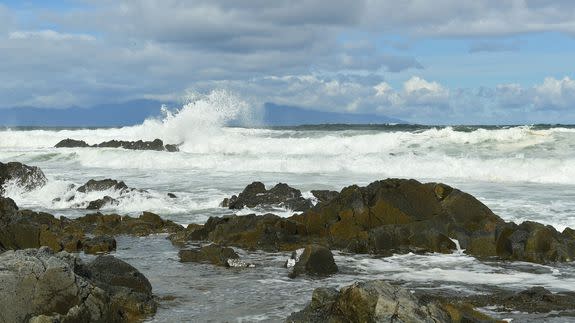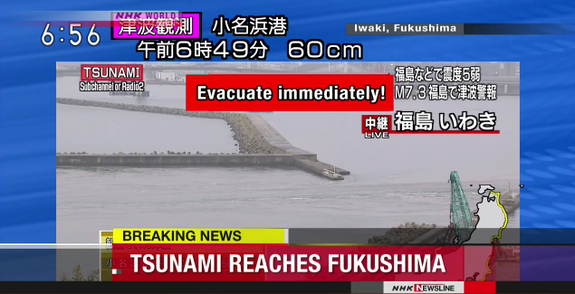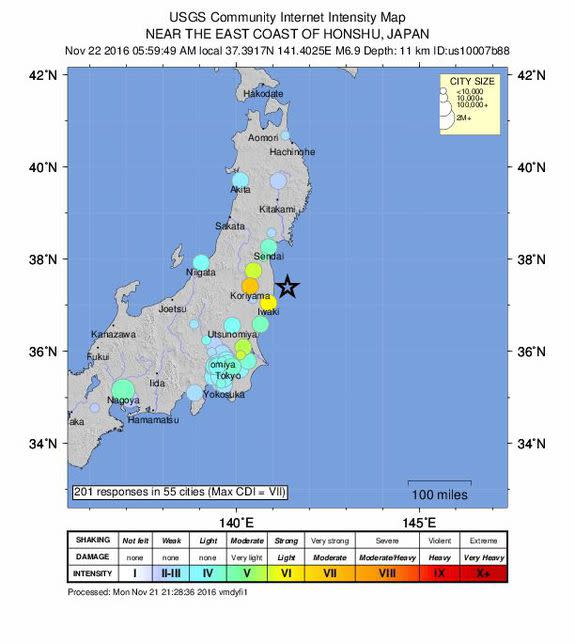Tsunami warning issued for Fukushima, Japan after powerful earthquake

A magnitude 6.9 earthquake struck off the coast of Fukushima, Japan, early Tuesday morning local time, prompting fears of a dangerous tsunami.
Japanese officials issued a tsunami warning for Fukushima prefecture for waves of up to three meters (10 feet). Residents along Japan's eastern coast were urged to move inland and seek higher ground.
SEE ALSO: New Zealand's earthquake literally cracked the Earth open
The first tsunami waves, measuring 60 centimeters high, reached Fukushima's Onahama port at 6:49 a.m. local time, Japanese media reported.
Sirens blared early Tuesday as newscasters warned residents to evacuate immediately.
Almost a 1 meter Tsunami observed.. #Japan #Fukushima pic.twitter.com/bIBT1lYRYW
— Robert Speta (@robertspeta) November 21, 2016

Image: NHK World live
In 2011, a magnitude 9.1 earthquake near Fukushima triggered 30-foot waves that killed more than 15,800 people and caused a devastating meltdown at a nuclear power plant in Fukushima.
Tepco, the power plant's operator, said via Twitter that "no abnormalities" were found at the nuclear reactors as of 5:59 a.m. local time.
No abnormalities found at #TEPCO’s #Nuclear Power Stations after Magnitude 7.3 #earthquake off the coast of #Fukushima at 5:59JST Nov 22.
— TEPCO (@TEPCO_English) November 21, 2016
The U.S. Geological Survey (USGS) initially listed Tuesday's earthquake as magnitude 7.3 before changing it to magnitude 6.9.
Japan is particularly vulnerable to earthquakes because it sits on the Pacific Ocean's Ring of Fire, an arc of seismic faults where about 90 percent of the world's earthquakes happen, according to USGS.
New Zealand, another island nation within the ring, suffered a damaging magnitude 7.8 earthquake earlier this month.
Earthquakes happen when two blocks of earth suddenly "slip" past one another on a fault plane.

Image: U.S. Geological Survey
The large-scale displacement of seafloor can trigger very long waves that coalesce into a tsunami. The waves travel outward on the ocean's surface, like ripples in a pond, and can slow down but grow in size as they come ashore.
In Japan on Tuesday, as news of the tsunami threat first rolled in, pet owners shared photos of their rattled cats and dogs, which were apparently spooked by the morning's earthquake.
大きめの地震だしユラユラ長くてビックリしました。まだ揺れますが海に近い方は気をつけて高いところへ! pic.twitter.com/ycPUVn5U02
— ムム (@0mumu0) November 21, 2016
緊急地震速報を知らせるあの独特の音…まだ大きな被害は出ていないようだけど…本当に胸がぎゅーってなる😞💭津波の警報・注意報のところは特にもお気をつけください😖💧 pic.twitter.com/YOCMP797fJ
— はの子 (@hanoko_55) November 21, 2016
UPDATE Nov. 21 8:22 p.m. ET: The tsunami warning was lifted around 10 a.m. Tuesday local time.
BREAKING: Japan lifts tsunami warning after magnitude 7.4 earthquake off Fukushima coast.
— The Associated Press (@AP) November 22, 2016
